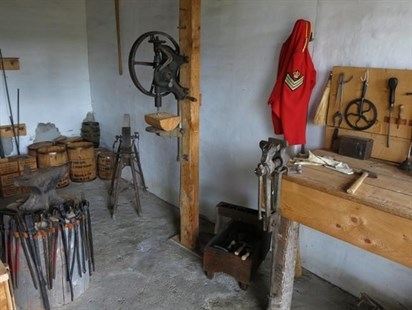
The blacksmith's shop at a replica of Fort Walsh, Sask., on August 21, 2015. The original fort was built by the NWMP in 1875 and only two kilometres from the site of the Cypress Hills Massacre, where more than 20 First Nations people were murdered on June 1, 1873.
Image Credit: THE CANADIAN PRESS/Bill Graveland
September 08, 2015 - 7:00 AM
FORT WALSH, Sask. - One of Canada's worst mass murders occurred in what is now a remote area of southwestern Saskatchewan, but experts say it barely registers as a footnote in Canadian history today.
The silence at Fort Walsh Historical Site, 60 kilometres from the U.S. border in Cypress Hills Provincial Park, can be deafening at times.
But on June 1, 1873, an altercation erupted just two kilometres from Fort Walsh between a small band of Nakoda (Assiniboine) people and a group of American wolfers. The wolfers would poison buffalo carcasses left behind by robe traders and then harvest fur from the dead wolves and coyotes that ate the tainted meat.
A misunderstanding over missing horses, fuelled by alcohol, led to the bloody slaughter. When the dust settled, at least 23 natives —men, women and children — were killed along with one of the wolfers.
"There were atrocities conducted," said Clay Yarshenko, a heritage presenter at Fort Walsh. "They clubbed to death the wounded and some of the women were captured and some of the men tormented them through the night."
News of the massacre eventually made its way to Ottawa and Prime Minister John A. Macdonald.
A bill calling for the creation of the North West Mounted Police had already been passed, but pressure from the United States to take action on the slaughter and other unrest in the West sped up the process.
"It's the trigger that more or less forces Macdonald to move ahead with that Mountie implementation policy," said Bill Waiser, a University of Saskatchewan professor emeritus, who taught history for 33 years.
Macdonald would send 150 Mounties to Winnipeg and in 1874 the North West Mounted Police made their historic march westward.
"They could have chosen a much easier route but they deliberately followed the route that paralleled the international boundary as a symbol of Canadian sovereignty," said Waiser.
"Their trip westward is more or less announcing to the Americans that Canada not only has taken possession of this region, but there is a police presence.
"It's very symbolic."
Yarshenko said one of the first priorities for the arriving Mounties was to investigate the Cypress Hills massacre.
"By the spring of 1875, they arrested seven of the participants in the U.S., extradited them back to Canada and put five on trial," he said. "They were found not guilty.
"It's hard to prove first-degree murder and the men were released."
Three other men were captured in Canada, but the verdict was the same.
Yarshenko said the Cypress Hills massacre and the arrival of Chief Sitting Bull, who escaped across the border after defeating Lt.-Col. George Custer in 1876, focused international attention on the area for years.
But now, he said, most Canadians have forgotten.
"Seeing as most Canadians still live in Central Canada you don't get exposed to something that is impacting other people even through this place," said Yarshenko.
Replicas of the two trading posts remain at the site of the massacre along with a stone monument.
There have been First Nations ceremonies remembering the attack, but it's not something that is widely talked about, said Waiser.
"It's an ugly event. In my time on campus I lectured about it, we discussed it, but I've never been aware of any big commemoration of this event."
Follow @BillGraveland on Twitter
News from © The Canadian Press, 2015